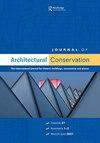Kenzo Tange and the ‘space of communication’: the never achieved project for the accessibility of the old town of Spoleto in Italy
IF 0.5
3区 艺术学
0 ARCHITECTURE
引用次数: 0
Abstract
ABSTRACT Kenzo Tange was deeply interested in the contemporary architectural culture and eager to incorporate, in his own formal register, typical traditional expressions. In his work, the structure of the city and the buildings is reconsidered as a ‘space of communications’, rich in symbolic values, where every form can have several meanings, and therefore have an impact on the compositional, constructive and functional approach. The plans he designed for Tokyo, Skopje and the Italian directional centres, show the fluid, technological and ever-changing dynamic that Tange experienced in 1987 in the Umbrian city of Spoleto, where he was called to submit a project to improve the urban accessibility for the old town. In Spoleto, he combined technological equipment, mechanised routes on electric sidewalks placed on the surface, in close contact with the city’s historical buildings, with particular attention to the conservation of all the stratified architecture of the historic city centre. The dialectic between the tradition and the creation, i.e. between the trend of a traditional repetition of forms and their overcoming, offers a gateway by which it’s possible to appreciate the genius of the architect and also to understand the demands of conservation from the perspective of innovation.Kenzo Tange和“交流空间”:意大利斯波莱托老城区的可达性从未实现的项目
【摘要】丹田贤三对当代建筑文化有着浓厚的兴趣,并渴望在自己的作品中融入典型的传统表达。在他的作品中,城市和建筑的结构被重新考虑为一个“交流空间”,具有丰富的象征价值,每种形式都可以有多种含义,因此对构图,构造和功能方法产生影响。他为东京、斯科普里和意大利方向中心设计的方案,展示了坦格1987年在翁布里亚的斯波莱托市所经历的流动、技术和不断变化的动态,在那里他被要求提交一个项目,以改善旧城区的城市可达性。在斯波莱托,他结合了技术设备,在地面上放置电动人行道上的机械化路线,与城市的历史建筑密切接触,特别注意保护历史城市中心的所有分层建筑。传统与创造之间的辩证关系,即传统形式重复的趋势与它们的克服之间的辩证关系,为欣赏建筑师的天才以及从创新的角度理解保护的需求提供了一扇大门。
本文章由计算机程序翻译,如有差异,请以英文原文为准。
求助全文
约1分钟内获得全文
求助全文

 求助内容:
求助内容: 应助结果提醒方式:
应助结果提醒方式:


